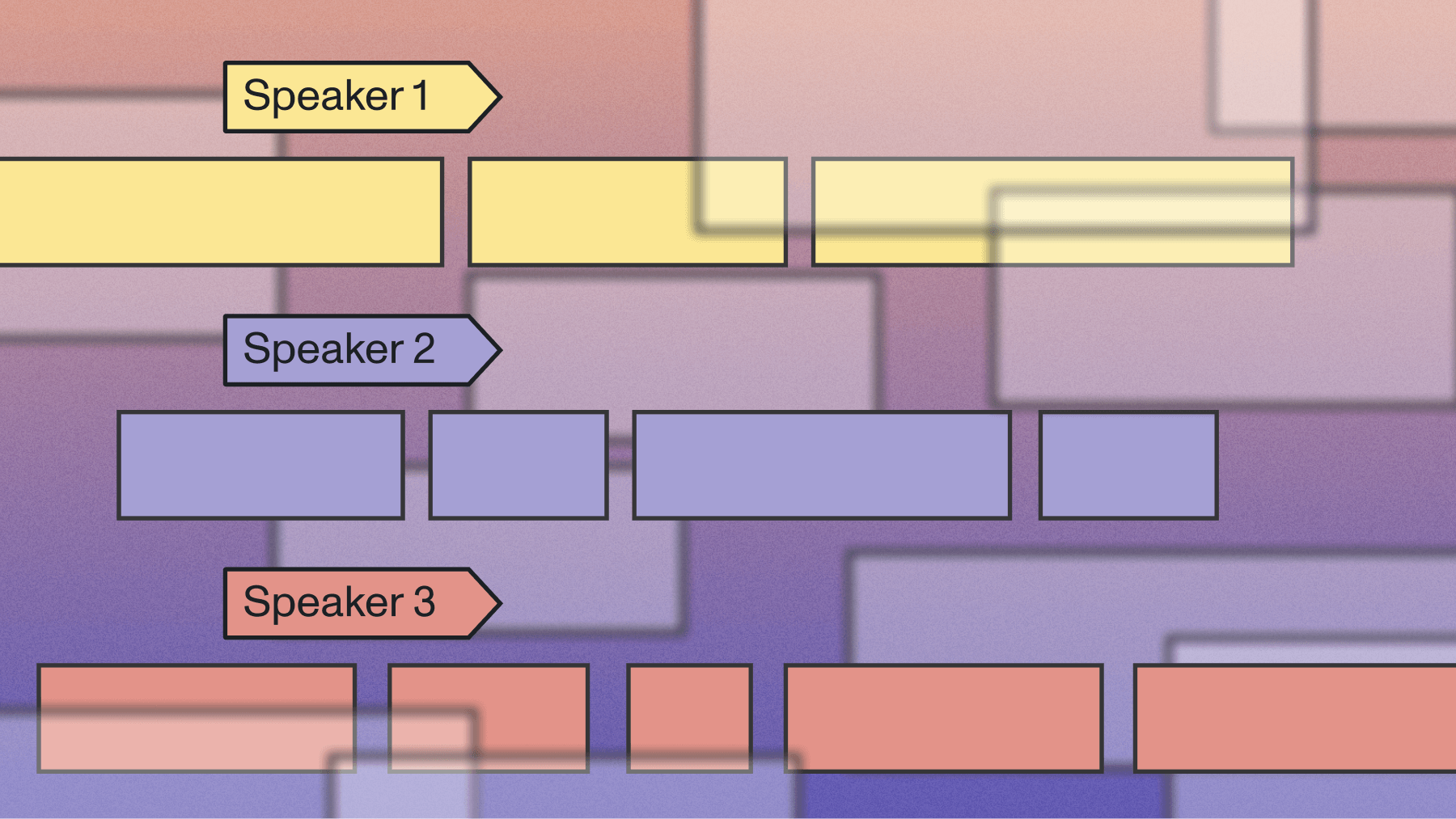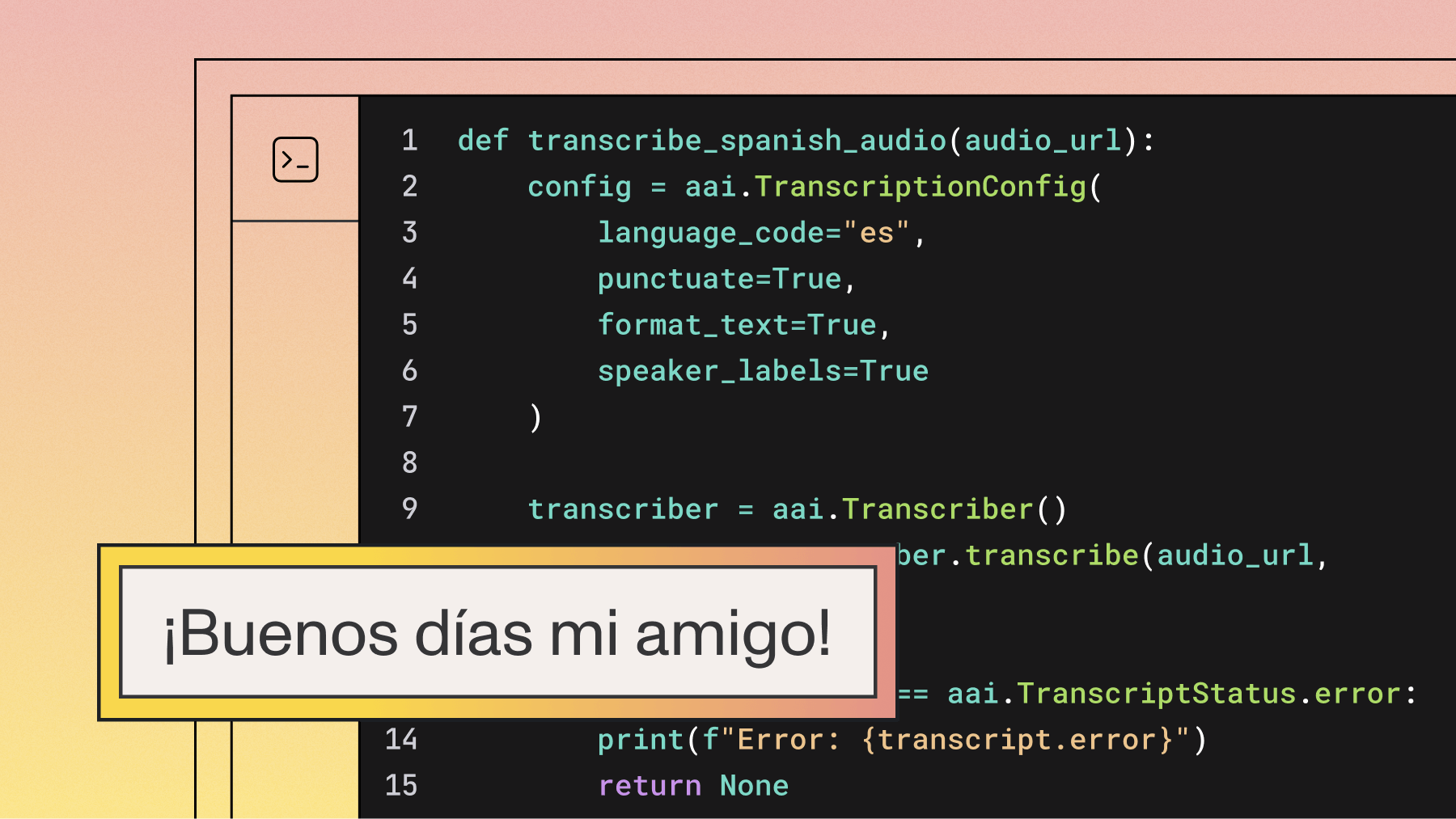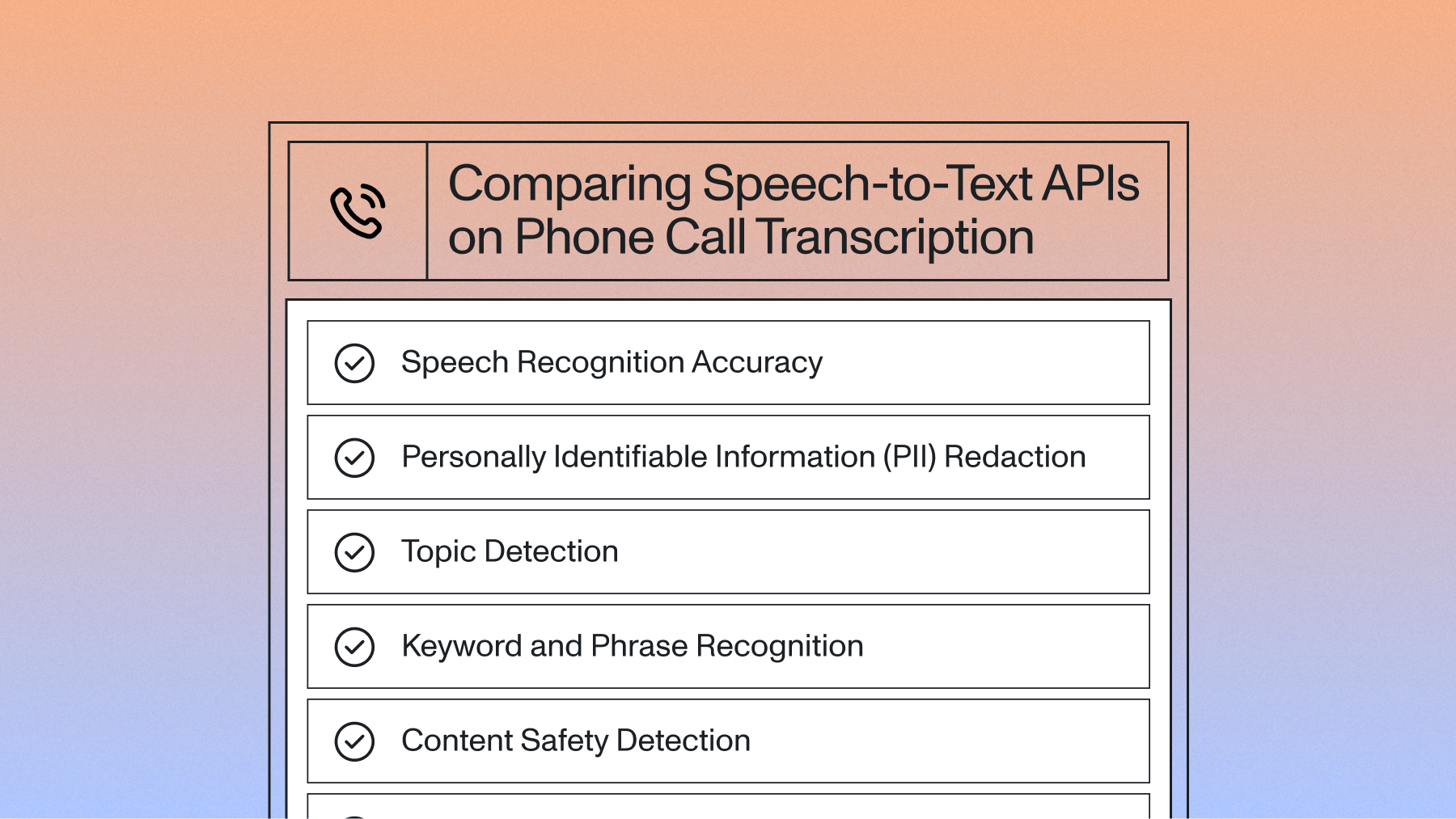5 Amazon Transcribe alternatives in 2025
This guide compares the top 5 Amazon Transcribe alternatives in 2025, covering their key features, pricing, and ideal use cases to help you choose the right speech-to-text API for your project.



Amazon Transcribe handles basic transcription needs, but many developers require higher accuracy, more advanced features, or simpler pricing as the speech-to-text market continues expanding rapidly. This guide compares the top 5 Amazon Transcribe alternatives in 2025, covering their key features, pricing, and ideal use cases to help you choose the right speech-to-text API for your project.
Amazon Transcribe alternatives comparison table
Amazon Transcribe alternatives are speech-to-text services that convert audio to text with different features, pricing, and accuracy levels than AWS's offering. These alternatives often provide better accuracy, more advanced features, simpler pricing, or superior developer experience for your specific needs.
What is Amazon Transcribe?
Amazon Transcribe is AWS's automatic speech recognition service that turns audio files into text using AI models. This means you upload audio files to AWS, and the service returns written transcripts of what was spoken.
The service works with both real-time streaming audio and batch files stored in S3 buckets. You can process phone calls, meetings, podcasts, or any audio content through their API using AWS SDKs.
Amazon Transcribe supports over 100 languages and includes speaker identification, custom vocabulary for industry terms, and automatic punctuation. However, you'll need an AWS account and familiarity with their ecosystem to get started.
Why look for Amazon Transcribe alternatives?
You might need an alternative when Amazon Transcribe's accuracy isn't good enough for your audio. The service struggles with background noise, multiple speakers talking over each other, or technical terminology that isn't in their standard vocabulary.
Cost becomes a major factor when you're processing thousands of hours monthly. Amazon's pricing can get expensive quickly, especially when you add features like speaker identification or custom vocabularies that cost extra.
The AWS-only approach creates friction if your team uses other cloud providers or wants to avoid vendor lock-in. You're forced to work within Amazon's ecosystem, which might not fit your existing infrastructure.
Common reasons teams switch:
- Poor accuracy: Transcripts need too much manual correction
- Missing features: No built-in sentiment analysis or content summarization
- Complex setup: Requires AWS expertise and account configuration
- Hidden costs: Extra charges for advanced features add up quickly
- Limited support: Hard to get help without expensive enterprise plans
Key features to consider in speech-to-text APIs
Modern speech-to-text APIs should handle real-world audio conditions like background noise, multiple speakers, and different accents without requiring perfect studio quality, as current accuracy benchmarks show significant performance variations across real-world scenarios. This means looking for services that maintain accuracy even when audio isn't ideal.
You'll want to evaluate whether the API includes speaker diarization, which identifies who said what in conversations. This feature is crucial for meeting transcripts, interviews, or any multi-person audio content.
Beyond basic transcription, consider whether you need speech understanding features like sentiment analysis, entity detection, or automatic summarization. These capabilities can extract insights from your transcripts without additional processing steps.
Essential features to evaluate:
- Real-time processing: Can handle live audio streams for applications like live captions
- Batch processing: Efficiently handles large files or multiple files at once
- Custom vocabulary: Adapts to your industry terms and proper nouns
- Multiple formats: Supports your audio file types (MP3, WAV, M4A, etc.)
- Developer experience: Clear documentation, SDKs, and responsive support
The best APIs provide confidence scores so you know which parts of the transcript might need review, and they format output with proper punctuation and capitalization for readable results.
Top 5 Amazon Transcribe alternatives
1. AssemblyAI
AssemblyAI is a speech-to-text API and voice AI platform that focuses on accuracy and speech understanding features. This means you get not just transcripts, but also insights like sentiment analysis, speaker diarization, and entity detection from the same API call.
AssemblyAI's Universal model for pre-recorded audio delivers high accuracy on challenging audio that other services struggle with. The Universal model handles everything from phone calls to podcasts without requiring you to choose between different model types. Users on G2 rate AssemblyAI at 4.8 out of 5 stars, with reviewers consistently noting performance on complex audio with background noise and multiple speakers.
What makes AssemblyAI different is the LLM gateway framework, which applies Large Language Models to your transcripts. This lets you automatically generate summaries, extract action items from meetings, or answer questions about the content without writing complex processing code.
The API includes speaker diarization to identify multiple speakers in your audio. You can enable features like sentiment analysis, topic detection, content moderation, and entity extraction in the same API call, with additional costs for these features. Companies like Supernormal and CallRail have improved their products using AssemblyAI, with CallRail improving transcription accuracy by up to 23%.
Why choose AssemblyAI:
- High accuracy: Maintains low Word Error Rate (WER) on noisy audio and multiple speakers (rated 4.8/5 on G2)
- All-in-one API: Transcription plus speech understanding in one call
- LLM gateway framework: Apply LLMs to transcripts for advanced analysis
- Simple pricing: Clear per-minute rate with transparent add-on pricing for advanced features
- Developer experience: Well-documented API with practical examples and responsive support (9.6/10 for Quality of Support on G2)
2. OpenAI Whisper
OpenAI Whisper is an open-source speech recognition model that you can run on your own servers or use through OpenAI's API. This means you have complete control over your data and can avoid per-minute charges if you self-host.
The open-source approach gives you flexibility. You can modify the model, run it entirely offline, or integrate it deeply into your existing systems without external dependencies.
Whisper handles 99 languages with decent accuracy, especially on clear audio. The model comes in different sizes from tiny (runs on mobile devices) to large (highest accuracy but requires powerful hardware).
If you don't want to manage infrastructure, OpenAI offers Whisper through their API at the lowest commercial rate available. However, you'll miss features like real-time streaming and speaker diarization that other services provide.
Why choose Whisper:
- Open source: Complete control over your data and deployment
- Lowest cost: Free if self-hosted, cheapest API if managed
- Language support: Excellent performance across 99 languages
- Flexible deployment: Run anywhere from mobile apps to data centers
3. Google Cloud Speech-to-Text
Google Cloud Speech-to-Text is Google's managed transcription service that integrates with their cloud platform. This means easy connections to BigQuery for analytics, Cloud Storage for file handling, and other Google services.
The service does well at handling diverse accents and languages through support for 125+ language variants.
AutoML lets you train custom models on your specific audio without machine learning expertise. You upload sample audio and transcripts, and Google automatically creates a model optimized for your use case.
The phrase hints feature boosts recognition of specific terms like product names or technical vocabulary. You just provide a list of important words, and the service prioritizes them during transcription.
Why choose Google Cloud Speech-to-Text:
- Language coverage: Good support for international content
- Google integration: Works seamlessly with other Google Cloud services
- AutoML training: Create custom models without ML expertise
- Enterprise features: Strong compliance and global infrastructure
4. Microsoft Azure Speech Services
Microsoft Azure Speech Services provides passable transcription with deep integration into Microsoft's ecosystem. This means native compatibility with Teams, Office 365, and other Microsoft products your organization might already use.
Custom Speech lets you adapt models to specific acoustic environments and vocabularies. You can train models to handle your office's acoustics, industry terminology, or specific speaker characteristics for improved accuracy.
The service includes unique features like pronunciation assessment, which scores how well someone pronounces words. This makes it valuable for language learning applications or accent training programs.
Azure's global infrastructure provides endpoints worldwide, and their compliance certifications meet enterprise security requirements. You also get neural text-to-speech voices in the same service for complete speech processing.
Why choose Azure Speech Services:
- Microsoft integration: Native Teams and Office compatibility
- Custom models: Adapt to your specific environment and vocabulary
- Global reach: Processing from multiple regions
- Complete platform: Speech-to-text and text-to-speech in one service
5. Deepgram
Deepgram is a speech-to-text service optimized for speed and call center analytics. This means fast processing of large audio files and features specifically designed for customer service and sales conversations.
Keyword boosting improves recognition of specific terms without training custom models. Just provide a list of important words like product names or company terminology, and Deepgram will prioritize them during transcription.
The service focuses on telephony audio and conversation analytics, with features designed for call centers and customer service teams. However, it lacks the broader speech understanding capabilities that modern applications increasingly need.
Why choose Deepgram:
- Call center focus: Optimized for customer service audio
- Keyword boosting: Easy way to improve specific term recognition
- Competitive pricing: Good value for high-volume processing
How to choose the right Amazon Transcribe alternative
Start by testing each service with your actual audio files, not perfect studio recordings. Upload the same challenging samples—ones with background noise, multiple speakers, or technical terms—to see how each service performs on your real-world content.
Consider your team's technical expertise and infrastructure preferences. Self-hosting Whisper requires machine learning operations knowledge, while managed APIs like AssemblyAI handle all the complexity for you.
Think about what features you need beyond basic transcription. If you want sentiment analysis, speaker diarization, or content summarization, choose a service that includes these capabilities rather than building them separately.
Decision factors by use case:
- For highest accuracy: AssemblyAI handles challenging audio well
- For real-time applications: AssemblyAI provides reliable streaming
- For Google Cloud users: Google Speech-to-Text integrates seamlessly
- For Microsoft environments: Azure Speech Services works natively with Office
Calculate total cost including engineering time, not just per-minute pricing. A slightly more expensive API that includes all features and great documentation often costs less overall than a cheaper option requiring extensive customization.
Don't forget about support and documentation quality. When you hit problems at 2am before a product launch, responsive support and clear troubleshooting guides become invaluable.
Final thoughts
The right Amazon Transcribe alternative transforms what's possible with your audio content. Instead of just getting basic transcripts that need manual cleanup, you can automatically extract insights, identify speakers, and generate summaries that drive real business value.
Most providers offer generous free trials, so test multiple options with your specific audio before committing. The differences in accuracy and features become obvious when you compare results side-by-side on your actual use case.
Switching providers later is straightforward if you design your integration properly. Focus on finding the service that best solves your immediate needs rather than trying to predict every future requirement.
Frequently asked questions
How does AssemblyAI compare to Amazon Transcribe for accuracy?
AssemblyAI's Universal model achieves higher accuracy than Amazon Transcribe on challenging audio with background noise, multiple speakers, or technical terminology. Users on G2 rate AssemblyAI's accuracy at 4.8/5 stars, with reviewers specifically noting strong performance on complex audio. AssemblyAI also includes speech understanding features like sentiment analysis and entity detection that Amazon Transcribe lacks. See AssemblyAI's accuracy benchmark report for detailed comparisons.
Can I use OpenAI Whisper without paying per-minute fees?
Yes, OpenAI Whisper is open-source and free to run on your own servers. You'll need to handle the infrastructure, GPU requirements, and model deployment yourself, but there are no per-minute charges for processing audio.
Which speech-to-text service works best for non-English languages?
Google Cloud Speech-to-Text supports the most languages with 125+ variants and generally performs well on international content. OpenAI Whisper also handles 99 languages effectively, especially for common languages like Spanish, French, and German.
Do I need an AWS account to use Amazon Transcribe alternatives?
No, most alternatives work independently of AWS. AssemblyAI, OpenAI Whisper, and Deepgram don't require any AWS setup. Only Google Cloud Speech-to-Text and Azure Speech Services require accounts with their respective cloud providers.
Lorem ipsum dolor sit amet, consectetur adipiscing elit, sed do eiusmod tempor incididunt ut labore et dolore magna aliqua. Ut enim ad minim veniam, quis nostrud exercitation ullamco laboris nisi ut aliquip ex ea commodo consequat. Duis aute irure dolor in reprehenderit in voluptate velit esse cillum dolore eu fugiat nulla pariatur.



.png)



